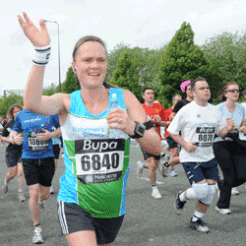![]()
Alzheimer’s Society has a special advantage in fundraising runs as the official charity partner of the Bupa Great Run Series – but this doesn’t make getting runners to raise cash any easier. Jayne Phenton takes us through the charity’s efforts to improve runner loyalty and fundraising return.
From the Garstang 10k to the 21-mile Grindleford Gallop, there are over a thousand opportunities in the UK for runners of all ages to sweat and grind their way to glory over a finishing line. Many are professional athletes, members of running clubs or motivated by fitness or personal goals, but with an estimated 25 per cent of participants running for charity, more and more third sector organisations are exploiting the fundraising potential of the run phenomena.
The challenge would is not just in recruiting people to run for your charity in the first place (a hard enough task), but encouraging them to raise as much money as possible and potentially winning their loyalty to your good cause and their support in the future.
Alzheimer’s Society’s has given a lot of attention to the fundraising potential of taking part in such events, a focus sharpened as we are Bupa’s nominated charity for the Bupa Great Run Series for the second year running. While a symbiotic relationship with Bupa brings many benefits – and Bupa and Alzheimer’s Society are engaged in a range of projects together - in terms of runner recruitment, being Bupa’s chosen charity is the goose that lays the golden tick box. It is the default position for many runners with no particular cause to run for. So securing runners wasn’t our biggest challenge. Last year, thanks to their Bupa nomination, Alzheimer’s Society and Alzheimer Scotland raised £1m from running challenges and this year they intend to exceed that figure.
Tick box fatigue
Of course, while many people may tick the box, translating those ticks into committed fundraisers is a different challenge. Runners who secure their own place, and then opt to run for your charity are particularly susceptible to abandoning any fundraising ambitions, as they are not tied into a minimum fundraising pledge.
Ellie Whitfield, Alzheimer’s Society project manager for the Bupa Great Run Series says, ‘We are realistic that there are some runners who just won’t raise any money and this tends to be at a much higher level in the Great runs than others. People literally may just tick a box’.
To counter this, Alzheimer’s Society now provide a fuller explanation at the sign up stage, making it clear that the box represents a clear commitment and runners will be sent fundraising packs in anticipation of them raising money.
Whitfield says this has led to less people ticking the box, but those who do sign up are more committed fundraisers. “It’s also helpful to give people more insight into what Alzheimer’s Society does which provides a powerful incentive,” she says.
Once runners have signed up, Alzheimer’s Society implements a tailored communications strategy for each runner. Acknowledgements are turned around within a week and followed by a series of newsletters including fundraising tools and tips, training advice and information to engage people with the cause they’re running for and understand what their hard won monies will fund.
Tailored communications are key to adding value to people’s experience. The communications which runners receive depend on the type of run they’re doing, how often they want to be contacted, through what media and with whichever information they want or require.
This saves people from feeling bombarded by emails or letters – or worse feeling neglected – and makes contact intimate and more inclusive.









